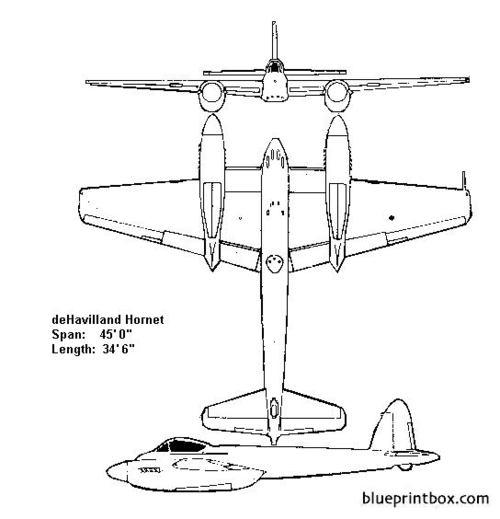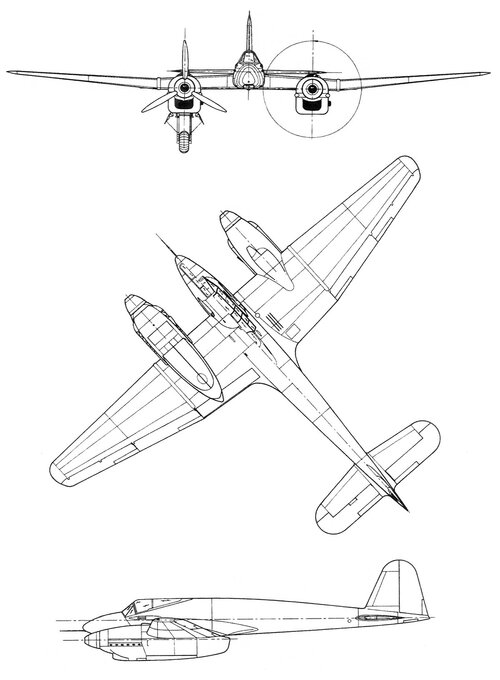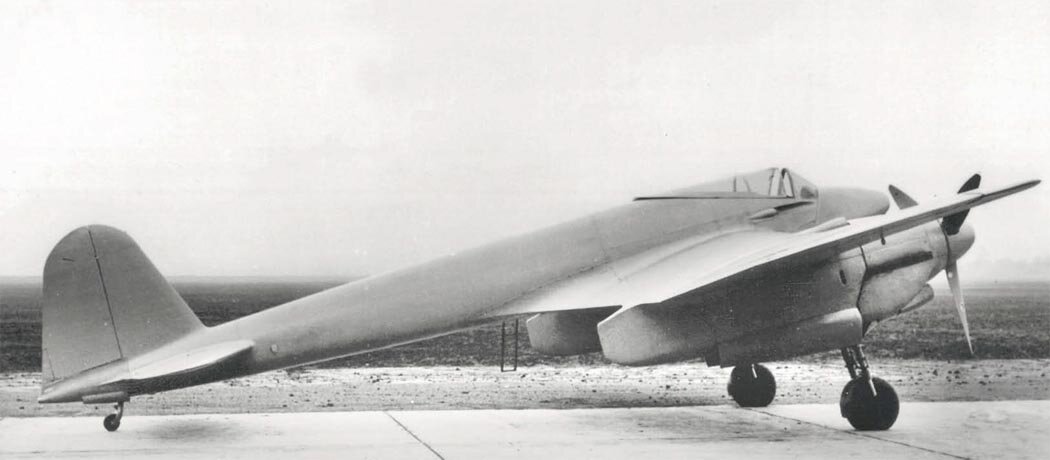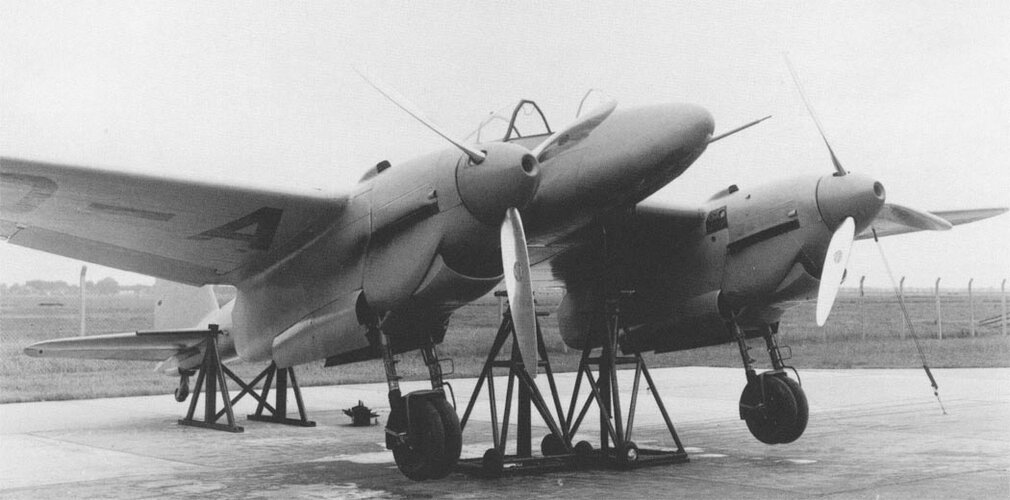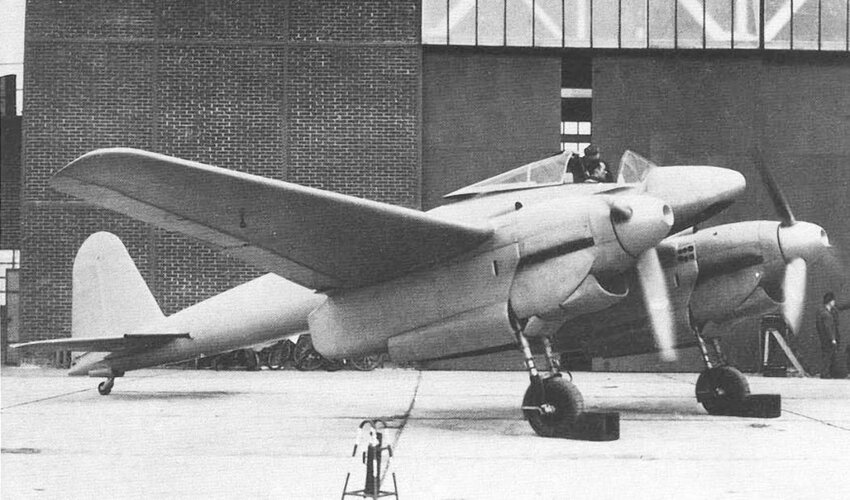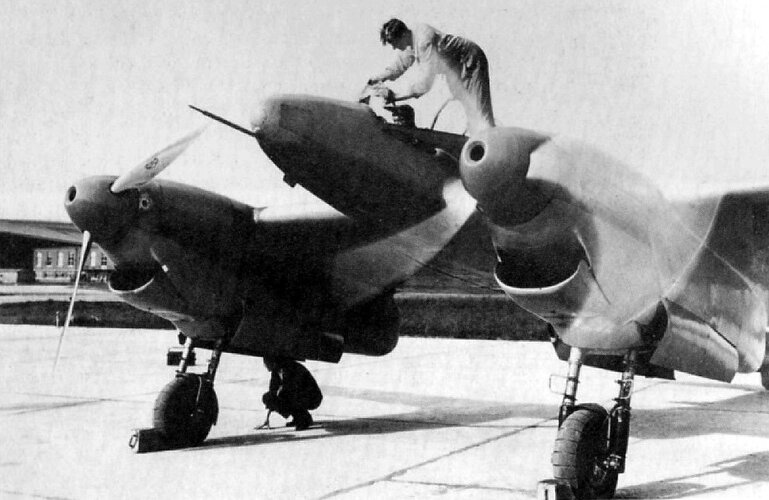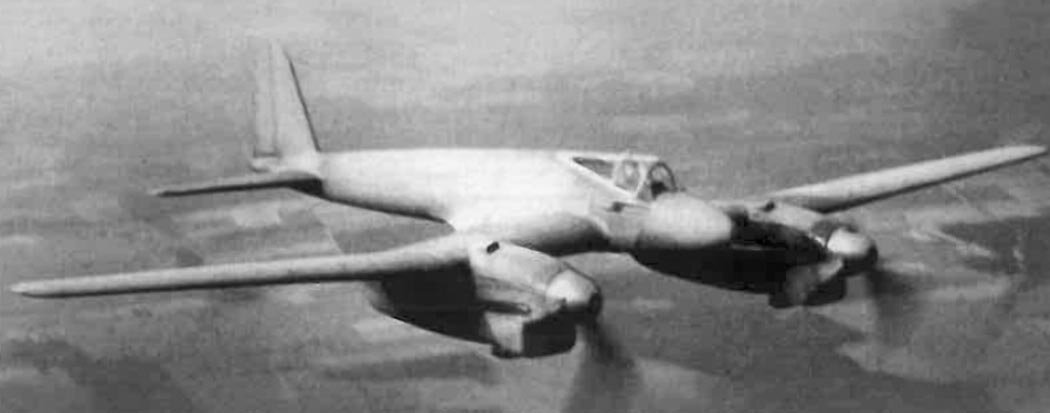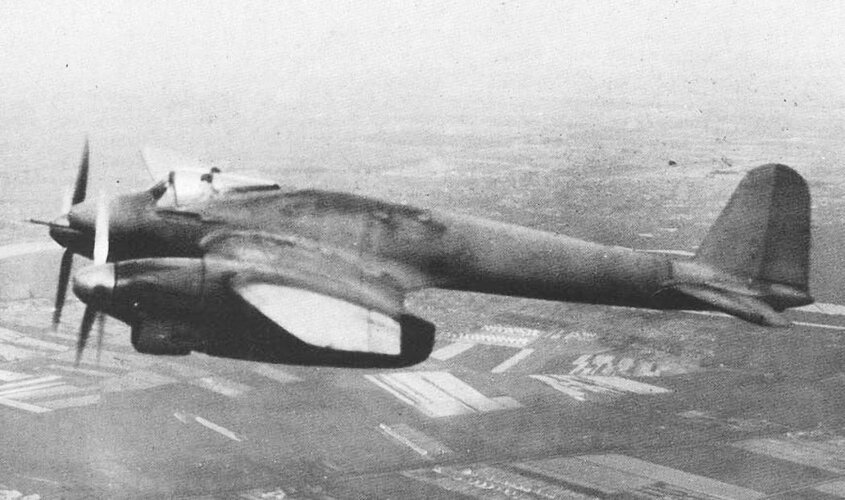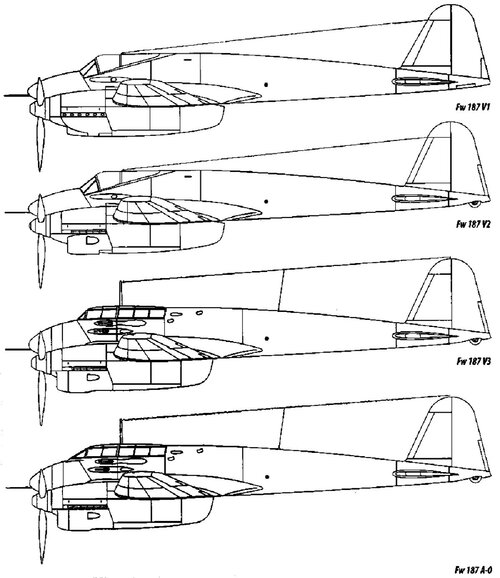You are using an out of date browser. It may not display this or other websites correctly.
You should upgrade or use an alternative browser.
You should upgrade or use an alternative browser.
Focke Wulf Fw-187
- Thread starter Justo Miranda
- Start date
nuuumannn
Cannae be ar*ed changing my personal text
- Joined
- 21 October 2011
- Messages
- 276
- Reaction score
- 537
Do you think that the Fw 187, had it been cleared for production, could have been developed into a fighter which
was on par with the De Havilland DH 103 Hornet boasting with similar performance and capabilities?
Possibly. anything is possible, but in its original incarnation with those big chunky radiators, then adding the gubbins required for production and military service that the prototypes didn't have, which would have slowed it down, I doubt it. In the Fw 187A-0 configuration, it was more than 100 mph slower than the production Hornet.
nuuumannn
Cannae be ar*ed changing my personal text
- Joined
- 21 October 2011
- Messages
- 276
- Reaction score
- 537
I don't necessarily buy the whole 'missed opportunity' theory behind this aircraft, for the simple fact that it was not designed to do everything that post-war enthusiasts state that it could have done. The aircraft had severely limited potential because of its small size.
firstly, let's look at the Zerstorer concept for which it was fielded against. The Zerstorer required a crew of three, internal stowage for cameras and carriage of bombs and use as a heavy fighter. The two-seater could not carry anything internally, there simply wasn't space. Aft of the cockpit was a fuel tank, take that out to fit cameras and its range would have been seriously depleted. Its bomb load could only be carried externally and then a maximum of one 1,000 kg bomb could be carried. A re-engined variant with BMW 801s could carry 1,500 kgs worth externally, but that only appeared in drawing form.
There's the idea that it could have been a night fighter variant of the single-seat heavy fighter. Firstly, the specialised fighter had a longer fuselage to the Zerstorer variant, which would have meant a separate production line, not only that but there was no space for radar equipment inside or outside the aeroplane. The typical German radar aerials could not have been fitted in the aircraft's nose, lest they be chopped up by the arc of the aircraft's propellers. Not only that, but space was so limited inside the cockpit that engine instruments were fitted outside the cockpit on the engine nacelles. That doesn't make for good instrument flying. So, our night fighter has one crew member, no radar and a hopelessly unergonomic cockpit environment. The pilot has a massive workload.
The proposed dive bomber variant had a different fuselage again as well as the BMW engines, so we are looking at three different fuselage configurations for different roles. The Fw factory drawings all show different fuselage and engine combinations that are distinct from one another. It simply was not a multi-role aircraft in its initial form. It could have been a single-seat twin-engined day fighter, OR a two-seat day fighter bomber with no photo-reconnaissance capability, OR a two-seat twin-engined dive bomber, BUT NOT a Zerstorer, or a night fighter, nor all of those things in the one airframe that so many enthusiasts claim it could be.
Hermann and Petrick's book is full of useful information, but its stated versatility just doesn't match the drawings that are reproduced in the book, nor the limitations as a result of its small size. Performance-wise, yes, it would have had good performance as a day fighter, no doubt, but you can guarantee its performance once put into production and service would have been lower than the claims made of it. I suspect the RLM made the right choice not to put it into production, besides, what would Fw not have built if it put it into production? The superlative Fw 190? I'd rather have the single-engined fighter, frankly.
firstly, let's look at the Zerstorer concept for which it was fielded against. The Zerstorer required a crew of three, internal stowage for cameras and carriage of bombs and use as a heavy fighter. The two-seater could not carry anything internally, there simply wasn't space. Aft of the cockpit was a fuel tank, take that out to fit cameras and its range would have been seriously depleted. Its bomb load could only be carried externally and then a maximum of one 1,000 kg bomb could be carried. A re-engined variant with BMW 801s could carry 1,500 kgs worth externally, but that only appeared in drawing form.
There's the idea that it could have been a night fighter variant of the single-seat heavy fighter. Firstly, the specialised fighter had a longer fuselage to the Zerstorer variant, which would have meant a separate production line, not only that but there was no space for radar equipment inside or outside the aeroplane. The typical German radar aerials could not have been fitted in the aircraft's nose, lest they be chopped up by the arc of the aircraft's propellers. Not only that, but space was so limited inside the cockpit that engine instruments were fitted outside the cockpit on the engine nacelles. That doesn't make for good instrument flying. So, our night fighter has one crew member, no radar and a hopelessly unergonomic cockpit environment. The pilot has a massive workload.
The proposed dive bomber variant had a different fuselage again as well as the BMW engines, so we are looking at three different fuselage configurations for different roles. The Fw factory drawings all show different fuselage and engine combinations that are distinct from one another. It simply was not a multi-role aircraft in its initial form. It could have been a single-seat twin-engined day fighter, OR a two-seat day fighter bomber with no photo-reconnaissance capability, OR a two-seat twin-engined dive bomber, BUT NOT a Zerstorer, or a night fighter, nor all of those things in the one airframe that so many enthusiasts claim it could be.
Hermann and Petrick's book is full of useful information, but its stated versatility just doesn't match the drawings that are reproduced in the book, nor the limitations as a result of its small size. Performance-wise, yes, it would have had good performance as a day fighter, no doubt, but you can guarantee its performance once put into production and service would have been lower than the claims made of it. I suspect the RLM made the right choice not to put it into production, besides, what would Fw not have built if it put it into production? The superlative Fw 190? I'd rather have the single-engined fighter, frankly.
- Joined
- 6 September 2006
- Messages
- 4,582
- Reaction score
- 8,514
Later nightfighter variants of the Me 110, such as the G, still had some engine dials on the inner engine cowlings, this feature seems to have endured throughout the entire 110 production, although with some differences in grouping. I always thought this an odd feature for the 110.
- Joined
- 11 June 2014
- Messages
- 1,450
- Reaction score
- 2,360
The proposed dive bomber variant had a different fuselage again as well as the BMW engines, so we are looking at three different fuselage configurations for different roles. The Fw factory drawings all show different fuselage and engine combinations that are distinct from one another. It simply was not a multi-role aircraft in its initial form. It could have been a single-seat twin-engined day fighter, OR a two-seat day fighter bomber with no photo-reconnaissance capability, OR a two-seat twin-engined dive bomber, BUT NOT a Zerstorer, or a night fighter, nor all of those things in the one airframe that so many enthusiasts claim it could be.
Wait, there was a proposed dive-bomber variant?
Hermann and Petrick seem to have got confused. There was no dive-bomber variant.
Last edited:
The Fw 187 had a small airframe. The Hornet's was just as small. The fuselage length was the same. Yet it could do almost everything.
The Zerstörer concept was crap and needed larger airframes. I wasn't envisioning the 187 as such. Just mentioning that it was so similar to the Hornet or the Ki-83 that
it could well have been going this route.
The annular/drum radiator arrangement, which was prevalent on Luftwaffe machines late war, had actually the most benefit, dragwise as well.
Napier conducted tests with various configurations and came to the same conclusion.
You can see here the various radiator installations compared:
Note the attachments as well.
The Zerstörer concept was crap and needed larger airframes. I wasn't envisioning the 187 as such. Just mentioning that it was so similar to the Hornet or the Ki-83 that
it could well have been going this route.
The annular/drum radiator arrangement, which was prevalent on Luftwaffe machines late war, had actually the most benefit, dragwise as well.
Napier conducted tests with various configurations and came to the same conclusion.
You can see here the various radiator installations compared:
Note the attachments as well.
taildragger
You can count on me - I won a contest
- Joined
- 2 November 2008
- Messages
- 387
- Reaction score
- 457
Very practical though since it would reduce weight, complexity and probably some maintenance requirements. The only downsides I can see would be that it must have made the pilot's scan pattern awkward and removed his ability to contol their ambient lighting for visibility.Later nightfighter variants of the Me 110, such as the G, still had some engine dials on the inner engine cowlings, this feature seems to have endured throughout the entire 110 production, although with some differences in grouping. I always thought this an odd feature for the 110.
nuuumannn
Cannae be ar*ed changing my personal text
- Joined
- 21 October 2011
- Messages
- 276
- Reaction score
- 537
A good number of german aircraft put the instruments on the engine cowling. Hs-129, some versions of the Ju-88, and I want to say early 111s or Dorniers too.
That doesn't mean it's a good thing to do if you can avoid it. At least those other aircraft weren't single-seat night fighters. The Bf 110 and Ju 88 etc had the benefit of other crewmembers. As for the Hornet Spicmart, like I said, the Fw 187 early production model was over 100 mph slower than the Hornet at a time when 20 to 30 mph is considered a big performance margin. That's a lot of drag reduction that needs to be done to get it to anywhere near the Hornet's performance, and you're talking about adding more for it to do?
blackkite
Don't laugh, don't cry, don't even curse, but.....
- Joined
- 31 May 2007
- Messages
- 8,567
- Reaction score
- 6,742
Hi! V1 with retractable radiator. (D-AANA)
http://www.airwar.ru/image/idop/fww2/fw187/
http://www.airwar.ru/image/idop/fww2/fw187/
Attachments
Last edited:
blackkite
Don't laugh, don't cry, don't even curse, but.....
- Joined
- 31 May 2007
- Messages
- 8,567
- Reaction score
- 6,742
Hi! V2.
" A second prototype followed with fixed radiators rather than earlier retractable versions, a semi-retractable tailwheel, changes to the elevator, and a vertical stabilizer with reduced chord. The engine was also upgraded to the 210G version of the Jumo, featuring direct fuel injection which resulted in a significant increase in power. New ejector-type exhaust stacks also contributed to increased speed by directing engine exhaust to the rear. Fw 187 V2 started testing in the summer of 1937, but crashed on landing when part of the main landing gear failed."(wikipedia)
" A second prototype followed with fixed radiators rather than earlier retractable versions, a semi-retractable tailwheel, changes to the elevator, and a vertical stabilizer with reduced chord. The engine was also upgraded to the 210G version of the Jumo, featuring direct fuel injection which resulted in a significant increase in power. New ejector-type exhaust stacks also contributed to increased speed by directing engine exhaust to the rear. Fw 187 V2 started testing in the summer of 1937, but crashed on landing when part of the main landing gear failed."(wikipedia)
Attachments
Last edited:
- Joined
- 6 September 2006
- Messages
- 4,582
- Reaction score
- 8,514
The Fw 187 couldn't even match the performance of its closer rivals of the time; the Gloster F.9/37 fitted with 1,000hp Taurus T-S(a) radials achieved 360mph at 15,000ft, weights were similar; the Grumman XF5F and XP-50 with 1,200hp Cyclones managed 380mph at sea level and had a very impressive 4,000ft/min rate of climb; the Westland Whirlwind was another very similar aircraft and much closer in terms of engine power with the 885hp Peregrine and also managed 360mph at 15,000ft but it did climb slower. The Lockheed P-38 was in an entirely different level of performance.
The later twin-engined fighters developed during the war were impressive performers, matching big high-power engines with refined aerodynamics. The Hornet's empty weight was the same as a loaded Fw 187A-0, it had a smooth skin from the wooden monocoque, Redux-bonded Alclad lower-wing surfaces, laminar-flow wings, slim engine nacelles, handed propellers, leading-edge ducted radiators and over 4,000hp from its Merlin 130/131 engines. Nothing was going to match that kind of pinnacle of aerodynamic and engine technology before 1945.
The closest Focke Wulf came was the Ta 154, getting about 400mph at 23,000ft out of two Jumo 213Es and 3,000ft/min climb out of the production A-1 nightfighter, roughly matching what the Mosquito was capable of and both sharing a comparable method of construction. The Ta 154V-1 with Jumo 211N engines did reach 440mph but was a prototype and not a production aircraft or fully equipped.
With the exception of the P-38 with its superior aerodynamics and engine power, none of these late 1930s single-seat twin-engined fighters actually progressed very far nor were they missed, arguably the P-38 had to find its niche too having been designed as an interceptor and then expected to be an escort fighter before finding its forte in ground attack. They were designed as high-altitude bomber-interceptors, a role that soon passed. Even the Hornet found itself mud-moving rather than tussling with single-seat fighters in its brief career. I'm not sure that the concept was missed by any of the combatants, single-engined fighters were superior and cheaper to build and the two/three-seat multi-role twin-engined type was far more versatile to spend wartime resources on.
The Fw 187 could barely fit the pilot, let alone a second crewman, so Focke Wulf was probably best in going back to the drawing board and its not clear that Luftwaffe doctrine had any more place for a single-seat twin-engined fighter than the RAF or USAAC did at the time.
The later twin-engined fighters developed during the war were impressive performers, matching big high-power engines with refined aerodynamics. The Hornet's empty weight was the same as a loaded Fw 187A-0, it had a smooth skin from the wooden monocoque, Redux-bonded Alclad lower-wing surfaces, laminar-flow wings, slim engine nacelles, handed propellers, leading-edge ducted radiators and over 4,000hp from its Merlin 130/131 engines. Nothing was going to match that kind of pinnacle of aerodynamic and engine technology before 1945.
The closest Focke Wulf came was the Ta 154, getting about 400mph at 23,000ft out of two Jumo 213Es and 3,000ft/min climb out of the production A-1 nightfighter, roughly matching what the Mosquito was capable of and both sharing a comparable method of construction. The Ta 154V-1 with Jumo 211N engines did reach 440mph but was a prototype and not a production aircraft or fully equipped.
With the exception of the P-38 with its superior aerodynamics and engine power, none of these late 1930s single-seat twin-engined fighters actually progressed very far nor were they missed, arguably the P-38 had to find its niche too having been designed as an interceptor and then expected to be an escort fighter before finding its forte in ground attack. They were designed as high-altitude bomber-interceptors, a role that soon passed. Even the Hornet found itself mud-moving rather than tussling with single-seat fighters in its brief career. I'm not sure that the concept was missed by any of the combatants, single-engined fighters were superior and cheaper to build and the two/three-seat multi-role twin-engined type was far more versatile to spend wartime resources on.
The Fw 187 could barely fit the pilot, let alone a second crewman, so Focke Wulf was probably best in going back to the drawing board and its not clear that Luftwaffe doctrine had any more place for a single-seat twin-engined fighter than the RAF or USAAC did at the time.
A good number of german aircraft put the instruments on the engine cowling. Hs-129, some versions of the Ju-88, and I want to say early 111s or Dorniers too.
That doesn't mean it's a good thing to do if you can avoid it. At least those other aircraft weren't single-seat night fighters. The Bf 110 and Ju 88 etc had the benefit of other crewmembers. As for the Hornet Spicmart, like I said, the Fw 187 early production model was over 100 mph slower than the Hornet at a time when 20 to 30 mph is considered a big performance margin. That's a lot of drag reduction that needs to be done to get it to anywhere near the Hornet's performance, and you're talking about adding more for it to do?
Why do you compare a Fw 187A-0 which was produced in summer of 1939 with DH F.1 Hornet which entered production end of 1944?!?
Not a fair comparison.
As the links I posted show the annular/drum radiator installation is less draggy even than leading edge radiators.
The Fw 187 couldn't even match the performance of its closer rivals of the time; the Gloster F.9/37 fitted with 1,000hp Taurus T-S(a) radials achieved 360mph at 15,000ft, weights were similar; the Grumman XF5F and XP-50 with 1,200hp Cyclones managed 380mph at sea level and had a very impressive 4,000ft/min rate of climb; the Westland Whirlwind was another very similar aircraft and much closer in terms of engine power with the 885hp Peregrine and also managed 360mph at 15,000ft but it did climb slower. The Lockheed P-38 was in an entirely different level of performance.
The later twin-engined fighters developed during the war were impressive performers, matching big high-power engines with refined aerodynamics. The Hornet's empty weight was the same as a loaded Fw 187A-0, it had a smooth skin from the wooden monocoque, Redux-bonded Alclad lower-wing surfaces, laminar-flow wings, slim engine nacelles, handed propellers, leading-edge ducted radiators and over 4,000hp from its Merlin 130/131 engines. Nothing was going to match that kind of pinnacle of aerodynamic and engine technology before 1945.
The closest Focke Wulf came was the Ta 154, getting about 400mph at 23,000ft out of two Jumo 213Es and 3,000ft/min climb out of the production A-1 nightfighter, roughly matching what the Mosquito was capable of and both sharing a comparable method of construction. The Ta 154V-1 with Jumo 211N engines did reach 440mph but was a prototype and not a production aircraft or fully equipped.
With the exception of the P-38 with its superior aerodynamics and engine power, none of these late 1930s single-seat twin-engined fighters actually progressed very far nor were they missed, arguably the P-38 had to find its niche too having been designed as an interceptor and then expected to be an escort fighter before finding its forte in ground attack. They were designed as high-altitude bomber-interceptors, a role that soon passed. Even the Hornet found itself mud-moving rather than tussling with single-seat fighters in its brief career. I'm not sure that the concept was missed by any of the combatants, single-engined fighters were superior and cheaper to build and the two/three-seat multi-role twin-engined type was far more versatile to spend wartime resources on.
The Fw 187 could barely fit the pilot, let alone a second crewman, so Focke Wulf was probably best in going back to the drawing board and its not clear that Luftwaffe doctrine had any more place for a single-seat twin-engined fighter than the RAF or USAAC did at the time.
I'd say that the XF5F and XP-50 had similar potential to te Fw 187. The Whirlwind being quite small which would limit its development potential.
Afaik the P-38 had compressibility issues.
Apart from its smooth skin and laminar flow wing I don't see why the Fw-187 should take much less load than the Hornet given that equipment weight and dimensions were similar.
Focke Wulf planned a Ta 152 with laminar flow wing which due to the course of the war never materialzed. Why should that not be possible for the 187?
Late war DB 605 versions were capable of about 2000 PS. As much as the Hornet's Merlins.
The diameter of the Hornet's engines is supremely thin. But its radiators were draggier.
The Hornet might be a bit faster than such an Fw 187 but not by much.
An Fw 190D equipped with Jumo 213EB (let alone a Jumo 213J) was capable 787 km/h. Install two of them into a Fw 187.
- Joined
- 11 June 2014
- Messages
- 1,450
- Reaction score
- 2,360
The Fw 187 was really a relic of a bygone era even by the late 1930s. Design work on it commenced in February 1935, at a point when the only engine available for fighters was the rather weedy Jumo 10 (later known as the 210). At that point, literally every fighter design was intended to feature the Jumo - the Ar 80, Fw 57, Fw 159, He 112, Hs 124, Bf 109 and Bf 110. The Fw 187 wasn't classified or referred to as a Zerstoerer until much later - it was originally a 'Leichter Jagdeinsitzer' in the same category as the Bf 109 and He 112, as Hood points out.
It's telling that when other designs started being specified with the DB 601 (first mention in RLM development charts is Oct 1, 1936; the first two designs to be specified with it being the Fw 259 and Bf 109) the Fw 187 kept the 210. The 601 was a larger engine in every dimension and given the 187's own compact form Focke-Wulf would presumably have had to completely redesign the aircraft to accommodate them.
I think perhaps the Fw 187's 'modern' looks give people the wrong idea about it.
In fact, when the aircraft got its second revival in 1942 (Erhard Milch found a brochure for it lying around in his office and asked Focke-Wulf to investigate whether the design could be modernised - that's how Milch himself describes what happened) it did have to be redesigned in order to suit either the DB 605 or DB 628.
Even after the Fw 187 had been rejected for the third time and even when the Ta 211 (Ta 154) was in development, Focke-Wulf continued to design twin-engine low-wing single-seat fighters. There's a couple of drawings for one powered by two BMW 801 As, dated May 1943, kicking around somewhere.
EDIT: The drawings mentioned above actually date from Feb 1943 and the design was to be powered by BMW 801 Fs not As.
It's telling that when other designs started being specified with the DB 601 (first mention in RLM development charts is Oct 1, 1936; the first two designs to be specified with it being the Fw 259 and Bf 109) the Fw 187 kept the 210. The 601 was a larger engine in every dimension and given the 187's own compact form Focke-Wulf would presumably have had to completely redesign the aircraft to accommodate them.
I think perhaps the Fw 187's 'modern' looks give people the wrong idea about it.
In fact, when the aircraft got its second revival in 1942 (Erhard Milch found a brochure for it lying around in his office and asked Focke-Wulf to investigate whether the design could be modernised - that's how Milch himself describes what happened) it did have to be redesigned in order to suit either the DB 605 or DB 628.
Even after the Fw 187 had been rejected for the third time and even when the Ta 211 (Ta 154) was in development, Focke-Wulf continued to design twin-engine low-wing single-seat fighters. There's a couple of drawings for one powered by two BMW 801 As, dated May 1943, kicking around somewhere.
EDIT: The drawings mentioned above actually date from Feb 1943 and the design was to be powered by BMW 801 Fs not As.
Last edited:
The Fw 187 was really a relic of a bygone era even by the late 1930s. Design work on it commenced in February 1935, at a point when the only engine available for fighters was the rather weedy Jumo 10 (later known as the 210). At that point, literally every fighter design was intended to feature the Jumo - the Ar 80, Fw 57, Fw 159, He 112, Hs 124, Bf 109 and Bf 110. The Fw 187 wasn't classified or referred to as a Zerstoerer until much later - it was originally a 'Leichter Jagdeinsitzer' in the same category as the Bf 109 and He 112, as Hood points out.
It's telling that when other designs started being specified with the DB 601 (first mention in RLM development charts is Oct 1, 1936; the first two designs to be specified with it being the Fw 259 and Bf 109) the Fw 187 kept the 210. The 601 was a larger engine in every dimension and given the 187's compact dimensions Focke-Wulf would presumably have had to completely redesign the aircraft to accommodate them.
I think perhaps the Fw 187's 'modern' looks give people the wrong idea about it.
In fact, when the aircraft got its second revival in 1942 (Erhard Milch found a brochure for it lying around in his office and asked Focke-Wulf to investigate whether the design could be modernised - that's literally how Milch himself describes what happened) it did have to be redesigned in order to suit either the DB 605 or DB 628.
Even after the Fw 187 had been rejected for the third time and even when the Ta 211 (Ta 154) was in development, Focke-Wulf continued to design twin-engine low-wing single-seat fighters. There's a couple of drawings for one powered by two BMW 801 As, dated May 1943, kicking around somewhere.
Why should a complete redesign be needed? People always appear to assume that excuse and discard the viability of succesful modification. Other planes of that era, just take the Spitfire and Bf 109, were upgraded, not redesigned but their basic designs stayed until the end of the war
Last edited:
- Joined
- 11 June 2014
- Messages
- 1,450
- Reaction score
- 2,360
The Fw 187 was really a relic of a bygone era even by the late 1930s. Design work on it commenced in February 1935, at a point when the only engine available for fighters was the rather weedy Jumo 10 (later known as the 210). At that point, literally every fighter design was intended to feature the Jumo - the Ar 80, Fw 57, Fw 159, He 112, Hs 124, Bf 109 and Bf 110. The Fw 187 wasn't classified or referred to as a Zerstoerer until much later - it was originally a 'Leichter Jagdeinsitzer' in the same category as the Bf 109 and He 112, as Hood points out.
It's telling that when other designs started being specified with the DB 601 (first mention in RLM development charts is Oct 1, 1936; the first two designs to be specified with it being the Fw 259 and Bf 109) the Fw 187 kept the 210. The 601 was a larger engine in every dimension and given the 187's compact dimensions Focke-Wulf would presumably have had to completely redesign the aircraft to accommodate them.
I think perhaps the Fw 187's 'modern' looks give people the wrong idea about it.
In fact, when the aircraft got its second revival in 1942 (Erhard Milch found a brochure for it lying around in his office and asked Focke-Wulf to investigate whether the design could be modernised - that's literally how Milch himself describes what happened) it did have to be redesigned in order to suit either the DB 605 or DB 628.
Even after the Fw 187 had been rejected for the third time and even when the Ta 211 (Ta 154) was in development, Focke-Wulf continued to design twin-engine low-wing single-seat fighters. There's a couple of drawings for one powered by two BMW 801 As, dated May 1943, kicking around somewhere.
Why should complete redesign needed? People always appear to assume that excuse and discard the viability of succesful modification. Other planes of that era, just take the Spitfire and Bf 109, were upgraded, not redesigned but their basic designs stayed until the end of the war
I seem to recall this same discussion playing out with regard to 'why didn't they fit the Whirlwind with Merlins'. The DB 601 was not only physically larger than the 210 but also 30% heavier and with a displacement of 33.9 litres compared to 19.7 litres. It wasn't as simple as unbolting the 210s and shoehorning a couple of 601s in. If that had been that easy, Focke-Wulf would have done it, at least experimentally, rather than see the 187 (and with it a substantial investment from the company) thrown away.
The Fw 187 was really a relic of a bygone era even by the late 1930s. Design work on it commenced in February 1935, at a point when the only engine available for fighters was the rather weedy Jumo 10 (later known as the 210). At that point, literally every fighter design was intended to feature the Jumo - the Ar 80, Fw 57, Fw 159, He 112, Hs 124, Bf 109 and Bf 110. The Fw 187 wasn't classified or referred to as a Zerstoerer until much later - it was originally a 'Leichter Jagdeinsitzer' in the same category as the Bf 109 and He 112, as Hood points out.
It's telling that when other designs started being specified with the DB 601 (first mention in RLM development charts is Oct 1, 1936; the first two designs to be specified with it being the Fw 259 and Bf 109) the Fw 187 kept the 210. The 601 was a larger engine in every dimension and given the 187's compact dimensions Focke-Wulf would presumably have had to completely redesign the aircraft to accommodate them.
I think perhaps the Fw 187's 'modern' looks give people the wrong idea about it.
In fact, when the aircraft got its second revival in 1942 (Erhard Milch found a brochure for it lying around in his office and asked Focke-Wulf to investigate whether the design could be modernised - that's literally how Milch himself describes what happened) it did have to be redesigned in order to suit either the DB 605 or DB 628.
Even after the Fw 187 had been rejected for the third time and even when the Ta 211 (Ta 154) was in development, Focke-Wulf continued to design twin-engine low-wing single-seat fighters. There's a couple of drawings for one powered by two BMW 801 As, dated May 1943, kicking around somewhere.
Why should complete redesign needed? People always appear to assume that excuse and discard the viability of succesful modification. Other planes of that era, just take the Spitfire and Bf 109, were upgraded, not redesigned but their basic designs stayed until the end of the war
I seem to recall this same discussion playing out with regard to 'why didn't they fit the Whirlwind with Merlins'. The DB 601 was not only physically larger than the 210 but also 30% heavier and with a displacement of 33.9 litres compared to 19.7 litres. It wasn't as simple as unbolting the 210s and shoehorning a couple of 601s in. If that had been that easy, Focke-Wulf would have done it, at least experimentally, rather than see the 187 (and with it a substantial investment from the company) thrown away.
I'm pretty sure Focke Wulf outlined it with up-engining in mind, like most aircraft design company probably. The Bf 109 started with a Jumo 210 as well and went to DB 605 in the end. Focke Wulf had a drawing of a Fw 187 with two BMW 801s, an engine which was heavier even than the Jumo 213 and DB 605.
- Joined
- 11 June 2014
- Messages
- 1,450
- Reaction score
- 2,360
I'm pretty sure Focke Wulf outlined it with up-engining in mind, like most aircraft design company probably. The Bf 109 started with a Jumo 210 as well and went to DB 605 in the end. Focke Wulf had a drawing of a Fw 187 with two BMW 801s, an engine which was heavier even than the Jumo 213 and DB 605.
Looking through Hermann and Petrick, it appears as though Focke-Wulf went to huge amounts of effort to re-engine the Fw 187 with the 601 following its first revival but couldn't manage it. The drawings showing the two BMW 801s are the completely redesigned 187 I mentioned earlier.
- Joined
- 8 March 2009
- Messages
- 1,013
- Reaction score
- 1,110
A good number of german aircraft put the instruments on the engine cowling. Hs-129, some versions of the Ju-88, and I want to say early 111s or Dorniers too.
That doesn't mean it's a good thing to do if you can avoid it. At least those other aircraft weren't single-seat night fighters. The Bf 110 and Ju 88 etc had the benefit of other crewmembers. As for the Hornet Spicmart, like I said, the Fw 187 early production model was over 100 mph slower than the Hornet at a time when 20 to 30 mph is considered a big performance margin. That's a lot of drag reduction that needs to be done to get it to anywhere near the Hornet's performance, and you're talking about adding more for it to do?
I didn't say it was a good idea, just that its a feature of German aircraft of that era. So was it the RLM requesting the instruments on the cowlings or did FW decide to copy some contemporary on their own?
Additionally I don't know what the point of comparing the 187 to the much later and higher horsepower hornet is. Figure out the drag count of the 187 and the like if you want to evaluate its relative aerodynamic merits.
- Joined
- 6 September 2006
- Messages
- 4,582
- Reaction score
- 8,514
Re-reading the relevant part of Rudiger Kosin's The German Fighter since 1915 (Putnam, 1988), its clear how much of an orphan it was from birth.
The 1934 technical requirements called for a single-engined fighter and a multi-seat Zerstoerer. Having failed with the Fw 159 previously, Kurt Tank went his own way with a twin-engine fighter and in November 1935 succeeded in gaining a development contract from the RLM despite the lack of any official requirements that matched the design. By the time it flew (late) it was, as pointed out earlier by me and newsdeskdan, a Leichter Jagdeinsitzer which put it up against the Bf 109 and He 112.
The V2 only had two 7.92mm MG 17, already the Bf 109 had three MG 17 and the option of one 20mm MG FF cannon. The Fw 187 despite having two engines was only 35km/h (21mph) faster (496km/h compared to 460km/h at 4,000m). Focke Wulf should have emphasised the additional range but seemingly never pressed its advantage. The RLM rejected it and the whole concept of a twin-engine Leichter Jagdeinsitzer. Instead they wanted a second crewman, two MG FF and two MG 17. Weight increased by a third and speed and range fell.
Kosin quotes from some LC II quarterly reports; (3 Sept 1938) "Fw 187 two-seat fighter with heavy armament and small range. Zero-series under construction, active service not currently planned... Project preparation includes the light combat aircraft as heavy dive-bomber and heavy fighter." Kosin notes that the light combat aircraft classification then included aircraft of the size and weight of the Ju 88A.
It seems like Focke Wulf was given Fw 187 contracts without any real intention of building any series fighters in its original single-seat form, it could be speculated they wanted to keep the company busy until other production programmes (Fw 190 would begin in 1938) bore fruit. The RLM even took the 8-187 designation away and re-assigned it to Junkers for the Stuka developments (Ju 187) - that shows the level of interest the RLM had in it by 1938-39.
The Hornet weighed around 15,800lb gross weight, the Fw 187A-0 11,023lb, which is 269lb less than the Hornet weighed empty despite being largely made of plywood. So the Fw 187 would need serious structural beefing up to add 4-5,000lb of gross weight for equipment, larger engines and fuel.
In fairness the weight of the guns and drag of the Matratze antennas for the FuG 212 C-1 Lichtenstein did reduce speed by about 25km/h, so a cleaned-up radar-less two-seat Ta 154 weighing about 19,600lb should be capable of 675-685km/h. Even the He 219 with DB603s did not exceed 670km/h at this altitude.
I think what you are really advocating is a Fw 187/Ta 154 hybrid, an all-metal single-seat Ta 154 with a laminar-flow wing and Jumo 213 engines. That would be nothing structurally or conceptionally similar to either the Fw 187 or the Ta 154.
Would the result be good as an interceptor or Zerstoerer engaging US bomber streams?
I think I would prefer the Me 262 for superior performance by the latter stages of the war. Even then it proved not quite agile enough to match the P-51 and Tempest in turning combat, a twin-Otto fighter would probably not fare any better either. The Hornet might have fared better against single-engine fighters, but the key to its success would probably be the abundance of power to claw its way through the air, the German DB603 and Jumo 213 falling just short of that 2,000+hp bracket (even before we get into high-octane fuel issues etc.).
The 1934 technical requirements called for a single-engined fighter and a multi-seat Zerstoerer. Having failed with the Fw 159 previously, Kurt Tank went his own way with a twin-engine fighter and in November 1935 succeeded in gaining a development contract from the RLM despite the lack of any official requirements that matched the design. By the time it flew (late) it was, as pointed out earlier by me and newsdeskdan, a Leichter Jagdeinsitzer which put it up against the Bf 109 and He 112.
The V2 only had two 7.92mm MG 17, already the Bf 109 had three MG 17 and the option of one 20mm MG FF cannon. The Fw 187 despite having two engines was only 35km/h (21mph) faster (496km/h compared to 460km/h at 4,000m). Focke Wulf should have emphasised the additional range but seemingly never pressed its advantage. The RLM rejected it and the whole concept of a twin-engine Leichter Jagdeinsitzer. Instead they wanted a second crewman, two MG FF and two MG 17. Weight increased by a third and speed and range fell.
Kosin quotes from some LC II quarterly reports; (3 Sept 1938) "Fw 187 two-seat fighter with heavy armament and small range. Zero-series under construction, active service not currently planned... Project preparation includes the light combat aircraft as heavy dive-bomber and heavy fighter." Kosin notes that the light combat aircraft classification then included aircraft of the size and weight of the Ju 88A.
It seems like Focke Wulf was given Fw 187 contracts without any real intention of building any series fighters in its original single-seat form, it could be speculated they wanted to keep the company busy until other production programmes (Fw 190 would begin in 1938) bore fruit. The RLM even took the 8-187 designation away and re-assigned it to Junkers for the Stuka developments (Ju 187) - that shows the level of interest the RLM had in it by 1938-39.
That smooth rivetless skin and laminar flow wing just about accounts of the largest causes of drag. The Fw 187 looks fairly narrow and clean in photographs but the devil is in the details that only wind tunnel test data can give us.Apart from its smooth skin and laminar flow wing I don't see why the Fw-187 should take much less load than the Hornet given that equipment weight and dimensions were similar.
The Hornet weighed around 15,800lb gross weight, the Fw 187A-0 11,023lb, which is 269lb less than the Hornet weighed empty despite being largely made of plywood. So the Fw 187 would need serious structural beefing up to add 4-5,000lb of gross weight for equipment, larger engines and fuel.
If anything the Ta 154 was a much better candidate for a laminar-flow wing.Focke Wulf planned a Ta 152 with laminar flow wing which due to the course of the war never materialzed. Why should that not be possible for the 187?
The Ta 154A-1 only achieved 650km/h (400mph) with two Jumo 213Es. Still lagging some 115km/h behind the Hornet.The Hornet might be a bit faster than such an Fw 187 but not by much.
An Fw 190D equipped with Jumo 213EB (let alone a Jumo 213J) was capable 787 km/h. Install two of them into a Fw 187.
In fairness the weight of the guns and drag of the Matratze antennas for the FuG 212 C-1 Lichtenstein did reduce speed by about 25km/h, so a cleaned-up radar-less two-seat Ta 154 weighing about 19,600lb should be capable of 675-685km/h. Even the He 219 with DB603s did not exceed 670km/h at this altitude.
I think what you are really advocating is a Fw 187/Ta 154 hybrid, an all-metal single-seat Ta 154 with a laminar-flow wing and Jumo 213 engines. That would be nothing structurally or conceptionally similar to either the Fw 187 or the Ta 154.
Would the result be good as an interceptor or Zerstoerer engaging US bomber streams?
I think I would prefer the Me 262 for superior performance by the latter stages of the war. Even then it proved not quite agile enough to match the P-51 and Tempest in turning combat, a twin-Otto fighter would probably not fare any better either. The Hornet might have fared better against single-engine fighters, but the key to its success would probably be the abundance of power to claw its way through the air, the German DB603 and Jumo 213 falling just short of that 2,000+hp bracket (even before we get into high-octane fuel issues etc.).
I'm pretty sure Focke Wulf outlined it with up-engining in mind, like most aircraft design company probably. The Bf 109 started with a Jumo 210 as well and went to DB 605 in the end. Focke Wulf had a drawing of a Fw 187 with two BMW 801s, an engine which was heavier even than the Jumo 213 and DB 605.
Looking through Hermann and Petrick, it appears as though Focke-Wulf went to huge amounts of effort to re-engine the Fw 187 with the 601 following its first revival but couldn't manage it. The drawings showing the two BMW 801s are the completely redesigned 187 I mentioned earlier.
I have the book of Hermann/Petrick as well. The Fw 187 was to be equipped with the DB 605. "Although this C-version was projected 4 years after the A-series, the differences were small" p.114 of the German edition. The Me 109E sported a DB 601, so why would this not have been possible in case of the Fw 187 ("despite huge amounts of efforts"-hyperbole?)? The basic airframe stayed the same as quoted, it might have been improved and strengthened, like in other planes' evolution. It was an up-engining effort, not a complete redesign.
- Joined
- 11 June 2014
- Messages
- 1,450
- Reaction score
- 2,360
I have the book of Hermann/Petrick as well. The Fw 187 was to be equipped with the DB 605. "Although this C-version was projected 4 years after the A-series, the differences were small" p.114 of the German edition. The Me 109E sported a DB 601, so why would this not have been possible in case of the Fw 187 ("despite huge amounts of efforts"-hyperbole?)? The basic airframe stayed the same as quoted, it might have been improved and strengthened, like in other planes' evolution. It was an up-engining effort, not a complete redesign.
So why didn't Focke-Wulf succeed in re-engining the Fw 187 with a DB 601, since a successful installation would have cured the aircraft's shortcomings?
- Joined
- 19 July 2016
- Messages
- 3,978
- Reaction score
- 3,030
Possibly political and/or priorities for production?
How much would the second crewmember plus accomodation weigh?Re-reading the relevant part of Rudiger Kosin's The German Fighter since 1915 (Putnam, 1988), its clear how much of an orphan it was from birth.
The 1934 technical requirements called for a single-engined fighter and a multi-seat Zerstoerer. Having failed with the Fw 159 previously, Kurt Tank went his own way with a twin-engine fighter and in November 1935 succeeded in gaining a development contract from the RLM despite the lack of any official requirements that matched the design. By the time it flew (late) it was, as pointed out earlier by me and newsdeskdan, a Leichter Jagdeinsitzer which put it up against the Bf 109 and He 112.
The V2 only had two 7.92mm MG 17, already the Bf 109 had three MG 17 and the option of one 20mm MG FF cannon. The Fw 187 despite having two engines was only 35km/h (21mph) faster (496km/h compared to 460km/h at 4,000m). Focke Wulf should have emphasised the additional range but seemingly never pressed its advantage. The RLM rejected it and the whole concept of a twin-engine Leichter Jagdeinsitzer. Instead they wanted a second crewman, two MG FF and two MG 17. Weight increased by a third and speed and range fell.
Kosin quotes from some LC II quarterly reports; (3 Sept 1938) "Fw 187 two-seat fighter with heavy armament and small range. Zero-series under construction, active service not currently planned... Project preparation includes the light combat aircraft as heavy dive-bomber and heavy fighter." Kosin notes that the light combat aircraft classification then included aircraft of the size and weight of the Ju 88A.
It seems like Focke Wulf was given Fw 187 contracts without any real intention of building any series fighters in its original single-seat form, it could be speculated they wanted to keep the company busy until other production programmes (Fw 190 would begin in 1938) bore fruit. The RLM even took the 8-187 designation away and re-assigned it to Junkers for the Stuka developments (Ju 187) - that shows the level of interest the RLM had in it by 1938-39.
That smooth rivetless skin and laminar flow wing just about accounts of the largest causes of drag. The Fw 187 looks fairly narrow and clean in photographs but the devil is in the details that only wind tunnel test data can give us.Apart from its smooth skin and laminar flow wing I don't see why the Fw-187 should take much less load than the Hornet given that equipment weight and dimensions were similar.
The Hornet weighed around 15,800lb gross weight, the Fw 187A-0 11,023lb, which is 269lb less than the Hornet weighed empty despite being largely made of plywood. So the Fw 187 would need serious structural beefing up to add 4-5,000lb of gross weight for equipment, larger engines and fuel.
Why the Ta 154?If anything the Ta 154 was a much better candidate for a laminar-flow wing.Focke Wulf planned a Ta 152 with laminar flow wing which due to the course of the war never materialzed. Why should that not be possible for the 187?
The Ta 154A-1 only achieved 650km/h (400mph) with two Jumo 213Es. Still lagging some 115km/h behind the Hornet.The Hornet might be a bit faster than such an Fw 187 but not by much.
An Fw 190D equipped with Jumo 213EB (let alone a Jumo 213J) was capable 787 km/h. Install two of them into a Fw 187.
You probably mean Jumo 213A which gave the Fw 190D-9 about 700 km/h. The two-stage E-version was deemed to be the only version which would have been decidely superior to the Mosquito, reaching well over 700 km/h at altitude. About 730 km/h IIRC.
In fairness the weight of the guns and drag of the Matratze antennas for the FuG 212 C-1 Lichtenstein did reduce speed by about 25km/h, so a cleaned-up radar-less two-seat Ta 154 weighing about 19,600lb should be capable of 675-685km/h. Even the He 219 with DB603s did not exceed 670km/h at this altitude.
I think what you are really advocating is a Fw 187/Ta 154 hybrid, an all-metal single-seat Ta 154 with a laminar-flow wing and Jumo 213 engines. That would be nothing structurally or conceptionally similar to either the Fw 187 or the Ta 154.
Would the result be good as an interceptor or Zerstoerer engaging US bomber streams?
I think I would prefer the Me 262 for superior performance by the latter stages of the war. Even then it proved not quite agile enough to match the P-51 and Tempest in turning combat, a twin-Otto fighter would probably not fare any better either. The Hornet might have fared better against single-engine fighters, but the key to its success would probably be the abundance of power to claw its way through the air, the German DB603 and Jumo 213 falling just short of that 2,000+hp bracket (even before we get into high-octane fuel issues etc.).
No advocating a hybrid. Just saying that the F 187 airframe might have been developed into a Hornet-like thingy when having been given green light by the RLM.
Late-war there were low-drag wing-mounted antennas. Not sure how much they aided top speed.
Last edited:
I have the book of Hermann/Petrick as well. The Fw 187 was to be equipped with the DB 605. "Although this C-version was projected 4 years after the A-series, the differences were small" p.114 of the German edition. The Me 109E sported a DB 601, so why would this not have been possible in case of the Fw 187 ("despite huge amounts of efforts"-hyperbole?)? The basic airframe stayed the same as quoted, it might have been improved and strengthened, like in other planes' evolution. It was an up-engining effort, not a complete redesign.
So why didn't Focke-Wulf succeed in re-engining the Fw 187 with a DB 601, since a successful installation would have cured the aircraft's shortcomings?
Sorry, I sense bias. Do you think that the Germans couldn't install a DB 601 (early war) when you see what other engines they built into airframes during the course of the war? Most designs had enough "stretch". When they had to enlarge the engine nacelles they would install an annular radiator which is drag-efficient.
Last edited:
- Joined
- 11 June 2014
- Messages
- 1,450
- Reaction score
- 2,360
Sorry, I sense bias. Do you think that the Germans couldn't install a DB 601 (pardon me, a lowly but important engine in the evolutionary rank of German propulsion up to 1945). When they had to enlarge the engine nacelles they would install an annular radiator which is drag-efficient.
I don't particularly dislike the Fw 187, nor do I particularly like it. It was an aircraft of its time. You said: "Why should a complete redesign be needed? People always appear to assume that excuse and discard the viability of succesful modification. Other planes of that era, just take the Spitfire and Bf 109, were upgraded, not redesigned but their basic designs stayed until the end of the war."
You appear to be suggesting that Focke-Wulf ought to have been able to re-engine the Fw 187 without substantial changes. So my question to you is, why did the company not do that?
Your second point in our discussion was: "I'm pretty sure Focke Wulf outlined it with up-engining in mind, like most aircraft design company probably. The Bf 109 started with a Jumo 210 as well and went to DB 605 in the end. Focke Wulf had a drawing of a Fw 187 with two BMW 801s, an engine which was heavier even than the Jumo 213 and DB 605."
You might be 'pretty sure' but there does not appear to be any surviving evidence to suggest that Focke-Wulf did design the Fw 187 with up-engining in mind. If you look at, for example, the RLM development charts from the mid-to-late 1930s (see examples attached below, dating from October 1, 1936), you can see that whereas most other designs had prototypes planned with different engine options installed (I've included the He 112 as an example), the Fw 187 didn't.
The Fw 187 went through three development phases. It was initially developed from 1935 to 1937 as a single seater, then it was revived as a two seater from 1939-1940. In both instances, the aircraft was designed for the Jumo 210. Surely if installing the DB 601 was straightforward, Focke-Wulf would have done it for the 1939-1940 prototypes. But they didn't.
Then it was revived again in 1942 at the behest of Milch - see attached scan from the cover of the promotional pamphlet produced by Focke-Wulf in August 1942 to showcase the design's features and a partial scan of one of the numerous massive drawings included in it (side view of the BMW 801 D-powered version). By this point, Focke-Wulf appears to have considered the installation of the 605, 628 and 801 D. But the project didn't get far enough for any detailed design work to commence so we cannot judge just how easy or hard it would have been to fit those engines to the Fw 187 airframe.
If you have primary source evidence of Focke-Wulf giving consideration to different engines for the Fw 187 before 1939, I would be glad to see and discuss it.

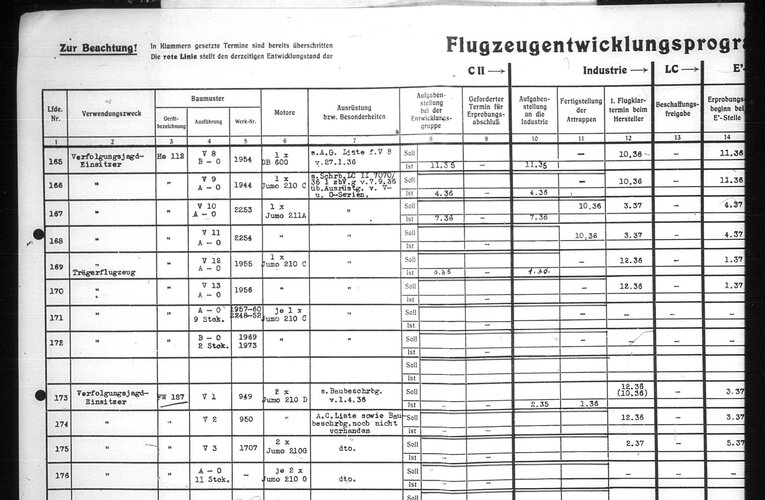
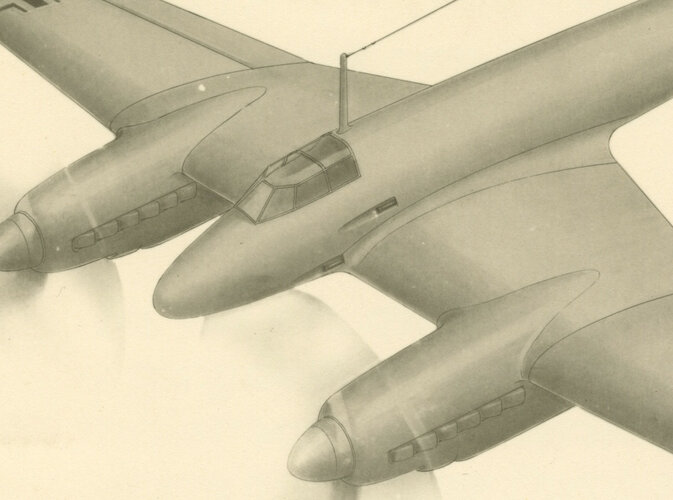
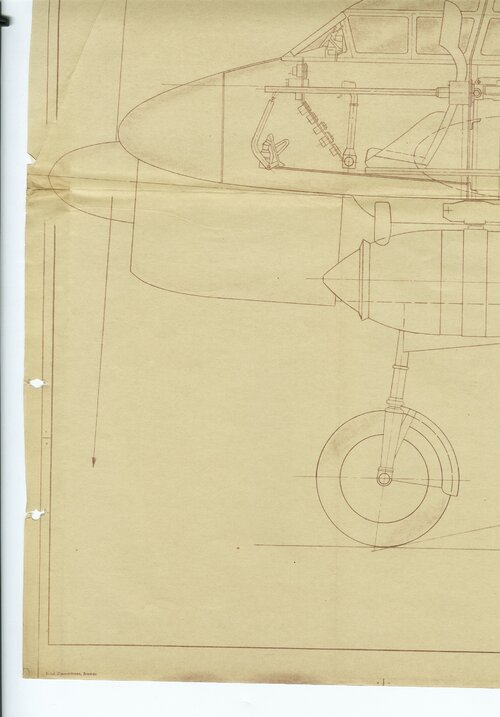
- Joined
- 11 June 2014
- Messages
- 1,450
- Reaction score
- 2,360
The 187 was originally designed for(and eventually flew with) DB600s. A single seat, 1400hp DB 601 powered Fw187 would have been a 400+mph fighter.
The RLM's development charts for the period suggest otherwise.
nuuumannn
Cannae be ar*ed changing my personal text
- Joined
- 21 October 2011
- Messages
- 276
- Reaction score
- 537
Additionally I don't know what the point of comparing the 187 to the much later and higher horsepower hornet is. Figure out the drag count of the 187 and the like if you want to evaluate its relative aerodynamic merits.
The comparison was not made by me, but spicmart, who simply asked if the Fw 187 could be made into a Hornet-like fighter. My answer is it's possible, but much work has to be done to achieve near the performance of the Hornet. A lot of drag reduction from its basic design.
Wait, there was a proposed dive-bomber variant?
Hermann and Petrick seem to have got confused. There was no dive-bomber variant.
There wasn't one built, but two were proposed, a single-seater and a two-seater. There's a factory drawing of the two-seater powered by BMW 801s dated 28 September 1940. It looks like it has a completely different wing, fuselage and engines compared to the existing aircraft. It would have been a completely different aeroplane to what was actually built.
So why didn't Focke-Wulf succeed in re-engining the Fw 187 with a DB 601, since a successful installation would have cured the aircraft's shortcomings?
it would have taken a lot more than that to cure any shortcomings it had in the eyes of the Luftwaffe/RLM. It was too small for starters. The Zerstorer specification gets criticism in the wake of the Battle of Britain but let's be honest, in the late 1930s when proposed, it wasn't much different from other heavy fighter/multi-role designs being produced at the time. The Bristol Blenheim, although a bomber was produced as a fighter, the Fokker G-1, the Beaufighter etc.
Remember, in 1937 through 1939 when this aeroplane and the Zerstorer concept was being acted on the Germans were not expecting to have invaded France, nor were they expecting to have made plans to attempt to attack Britain. German bombers barely had the range to reach the UK from Germany with anything but the smallest bomb loads; the Do 17Z could only go 300 kilometres or so with a 1,000 kg bomb load, for example. The Zerstorer concept was a bit of propagandistic bombast coupled with tactical necessity and numerical desire; one airframe that can do lots of stuff that can be produced in relatively large numbers, the Germans knew that a three-seat bomber reconnaissance aircraft couldn't possibly match a single-seat fighter, but Goring was a bit of a dreamer at any rate and believed his own propaganda. The Bf 110 was a very competent aircraft and had the Germans not invaded France was the country's only fighter option if it was expecting to go outside continental Europe from Germany. The Bf 109 simply didn't have the range.
Could the Fw 187 have acted as a better long-range fighter to fulfil what was the Luftwaffe's needs at that time? Undoubtedly, but the two-seat variant, the A-0 that was put into small production and that became the 'industry defence fighter' was not a multi-role aircraft. That idea didn't come until later.
nuuumannn
Cannae be ar*ed changing my personal text
- Joined
- 21 October 2011
- Messages
- 276
- Reaction score
- 537
If you have primary source evidence of Focke-Wulf giving consideration to different engines for the Fw 187 before 1939, I would be glad to see and discuss it.
Yup, nailed it in your post, Dan. The aircraft in its initial configurations was NOT a multi-role aircraft. It was a single-seat and two-seat fighter. In its later redesign in 1942 the RLM discontinued it and went with the Me 410 because it had more potential as a design. The Fw 187 was far too immature and, as I mentioned required substantial redesign from its original design to make it as versatile, which is what the RLM wanted in the first place. Yes, drawings were produced and performance figures were proposed, but it was discontinued before any groundwork to verify its viability was carried out. The expectations that are placed on this aircraft by modern-day 'experts' are made entirely without foundation.
- Joined
- 11 June 2014
- Messages
- 1,450
- Reaction score
- 2,360
There wasn't one built, but two were proposed, a single-seater and a two-seater. There's a factory drawing of the two-seater powered by BMW 801s dated 28 September 1940. It looks like it has a completely different wing, fuselage and engines compared to the existing aircraft. It would have been a completely different aeroplane to what was actually built.
The Baubeschreibung Nr. 233 and Nr. 235 designs were not connected to the Fw 187. I have both documents (see below) and neither one of them mentions the Fw 187 at all. I suppose if you're writing a book about the Fw 187 and something from Focke-Wulf looks a bit like it, you're going to add 2+2 and get 5. The '2-mot. Stuka (1 Mann)' and '2 mot. Stuka 2 Mann' are significantly different in their dimensions from the Fw 187. Hermann and Petrick were not correct in linking those designs to the Fw 187.
It's a shame they don't appear to have known about the low-wing 2 x BMW 801 F-powered single-seater design drawn up by Focke-Wulf in February 1943. That does look a bit like the 187.
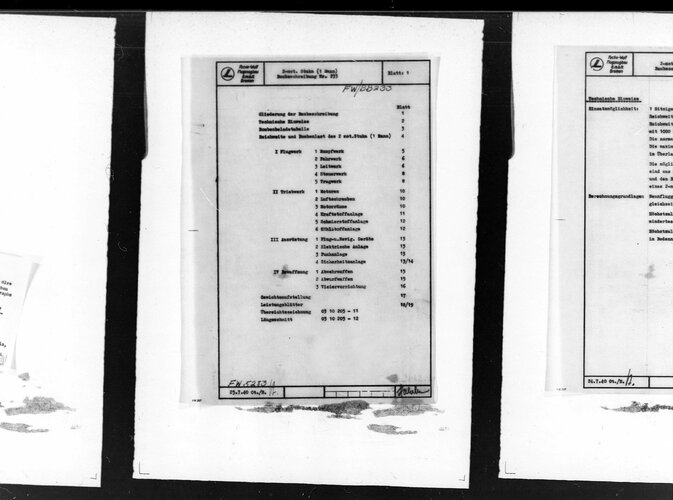
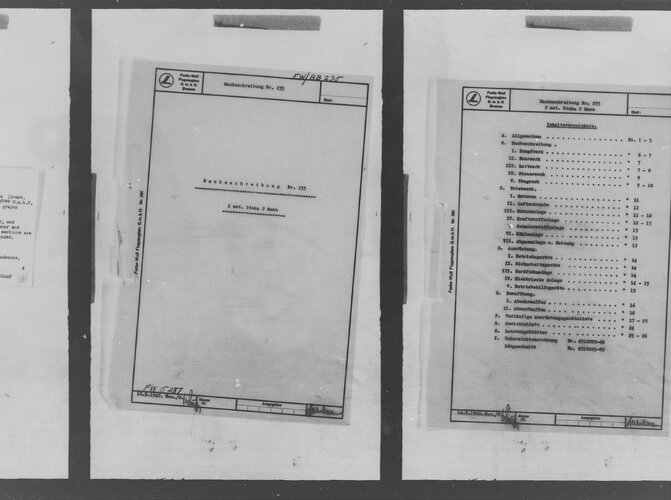
Last edited:
nuuumannn
Cannae be ar*ed changing my personal text
- Joined
- 21 October 2011
- Messages
- 276
- Reaction score
- 537
Hermann and Petrick were not correct in linking those designs to the Fw 187.
Possibly, but regardless of whether the specs mention the aircraft doesn't mean that Fw didn't produce a design for them. The drawing on p.99 doesn't name the aircraft as an Fw 187, but its lineage is obvious. Granted it has a different fuselage, wing, engines etc, its vertical tail is the same shape etc as the Fw 187, so it's easy to draw that conclusion. The Fw 187 was likely used as a basis for the design.
nuuumannn
Cannae be ar*ed changing my personal text
- Joined
- 21 October 2011
- Messages
- 276
- Reaction score
- 537
Why do you compare a Fw 187A-0 which was produced in summer of 1939 with DH F.1 Hornet which entered production end of 1944?!?
Not a fair comparison.
Because it's an indication of how much work needs to be done. Might as well start from scratch with a new design. Like I said, you want an Fw 187 that can be a 'Hornet'? Your basis IS that pre-war design.
- Joined
- 11 June 2014
- Messages
- 1,450
- Reaction score
- 2,360
Hermann and Petrick were not correct in linking those designs to the Fw 187.
Possibly, but regardless of whether the specs mention the aircraft doesn't mean that Fw didn't produce a design for them. The drawing on p.99 doesn't name the aircraft as an Fw 187, but its lineage is obvious. Granted it has a different fuselage, wing, engines etc, its vertical tail is the same shape etc as the Fw 187, so it's easy to draw that conclusion. The Fw 187 was likely used as a basis for the design.
I disagree. The Petrick and Hermann book has the chapter heading 'The Fw 187 as a Twin-Engined Dive Bomber' and states: "Focke-Wulf subsequently tried to modify the Fw 187 for the dive bombing role."
This is simply not true. The Baubeschreibung Nr. 233 and Nr. 235 designs represent new aircraft - they are not modifications of the existing Fw 187.
I have a fair degree of familiarity with Focke-Wulf project descriptions - see my collected list of there https://www.secretprojects.co.uk/threads/focke-wulf-flugzeugbau-gmbh.9751/
If a new project used components from an existing type, Focke-Wulf pointed that out. Any cost savings that could be made by reusing existing components might influence any decision made on the project by the RLM. There is, as I said, no mention of this in the Nr. 233 and Nr. 235 documents.
I don't see how it can easily be concluded that a design is a modification of an existing type based solely on the shape of its fin - when the fuselage, wings and engines are all new.
- Joined
- 8 March 2009
- Messages
- 1,013
- Reaction score
- 1,110
Additionally I don't know what the point of comparing the 187 to the much later and higher horsepower hornet is. Figure out the drag count of the 187 and the like if you want to evaluate its relative aerodynamic merits.
The comparison was not made by me, but spicmart, who simply asked if the Fw 187 could be made into a Hornet-like fighter. My answer is it's possible, but much work has to be done to achieve near the performance of the Hornet. A lot of drag reduction from its basic design.
And what are you basing "a lot of drag reduction" on. Have you calculated the flat plate area? The wetted area? The drag count? Because if not you shouldn't be making assumptions like that.
nuuumannn
Cannae be ar*ed changing my personal text
- Joined
- 21 October 2011
- Messages
- 276
- Reaction score
- 537
And what are you basing "a lot of drag reduction" on. Have you calculated the flat plate area? The wetted area? The drag count? Because if not you shouldn't be making assumptions like that.
Do I need to? Compare the speeds of the Fw 187 with that of the Hornet and it is plainly clear that the former requires drag reduction to achieve anywhere near the performance of the Hornet. You don't need to be an aerodynamicist to figure that out.
I have questions for you, if you were wanting to increase the Fw 187's given speeds by 100 mph, how would you do it? Would you simply put more powerful engines on it, given what was available to the Germans at the time, or would you investigate drag reduction measures as well, given that it needs to go into a wind tunnel to assess the result of new cowls, cooling modifications etc?
Last edited:
nuuumannn
Cannae be ar*ed changing my personal text
- Joined
- 21 October 2011
- Messages
- 276
- Reaction score
- 537
I disagree. The Petrick and Hermann book has the chapter heading 'The Fw 187 as a Twin-Engined Dive Bomber' and states: "Focke-Wulf subsequently tried to modify the Fw 187 for the dive bombing role."
This is simply not true. The Baubeschreibung Nr. 233 and Nr. 235 designs represent new aircraft - they are not modifications of the existing Fw 187.
I have a fair degree of familiarity with Focke-Wulf project descriptions - see my collected list of there https://www.secretprojects.co.uk/threads/focke-wulf-flugzeugbau-gmbh.9751/
If a new project used components from an existing type, Focke-Wulf pointed that out. Any cost savings that could be made by reusing existing components might influence any decision made on the project by the RLM. There is, as I said, no mention of this in the Nr. 233 and Nr. 235 documents.
I don't see how it can easily be concluded that a design is a modification of an existing type based solely on the shape of its fin - when the fuselage, wings and engines are all new.
I don't disagree with you based on what you know and have presented here, Dan, but I didn't conclude that it was, I stated that it's likely and that it is easy to draw that conclusion, and it is.
- Joined
- 8 March 2009
- Messages
- 1,013
- Reaction score
- 1,110
And what are you basing "a lot of drag reduction" on. Have you calculated the flat plate area? The wetted area? The drag count? Because if not you shouldn't be making assumptions like that.
Do I need to? Compare the speeds of the Fw 187 with that of the Hornet and it is plainly clear that the former requires drag reduction to achieve anywhere near the performance of the Hornet. You don't need to be an aerodynamicist to figure that out.
I have questions for you, if you were wanting to increase the Fw 187's given speeds by 100 mph, how would you do it? Would you simply put more powerful engines on it, given what was available to the Germans at the time, or would you investigate drag reduction measures as well, given that it needs to go into a wind tunnel to assess the result of new cowls, cooling modifications etc?
You can very easily figure this out using some simple math. The Cube rule is New speed =((new hp/old hp)*(old speed^3))^0.3333
Do the above and plug in 4020 for the new hp, since that is the hp of the Hornet, 1342 for old hp and 326 for old speed.
The number works out to 469.65mph, which is very close to the 475mph of the hornet. Doesn't really match up with your claim of it being a draggy airframe. You can also do the reverse to find out the approximate speed of the hornet with the same hp of the 187.
So yes, I'd say you need to do some basic math before making claims like that. And this is because you cannot simply eyeball this stuff, and you certainly need to have a very solid understanding of aerodynamics before you claim one airframe is draggy than other based off photos.
EDIT: forgot to mention this isn't the best comparison because it doesn't take altitude into account. If you do, like by using a flat plate based estimate, then the 187 would be capable of Hornet speeds with quite a bit less hp, probably several hundred minimum, maybe as high as 500 hp given the hornet was doing 475 at 21k and the 187 was hitting 326 at ~13k.
nuuumannn
Cannae be ar*ed changing my personal text
- Joined
- 21 October 2011
- Messages
- 276
- Reaction score
- 537
So yes, I'd say you need to do some basic math before making claims like that.
Nope, I won't (who are you to tell me what I can and can't write?) and I'll keep making claims like that because those figures are not done with the benefit of a wind tunnel and the measures you've claimed in your previous thread on the airframe. They are a simple calculation done without the benefit of hard research into the aerodynamic properties of either aircraft and don't prove a thing. There are loads of examples where aerodynamicists have produced figures that stated their designs would do a particular speed, but when the real things were built, they couldn't, so your figures prove nothing.
And this is because you cannot simply eyeball this stuff, and you certainly need to have a very solid understanding of aerodynamics before you claim one airframe is draggy than other based off photos.
Yes you can! It's easy mate and you don't need to do a calculation! Look at the figures for both aircraft! How do you suspect to improve the speed of one to achieve the other to that extent without drag reduction measures!
Last edited:

